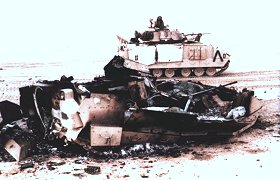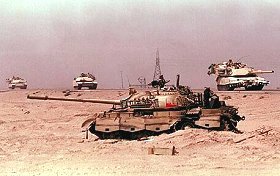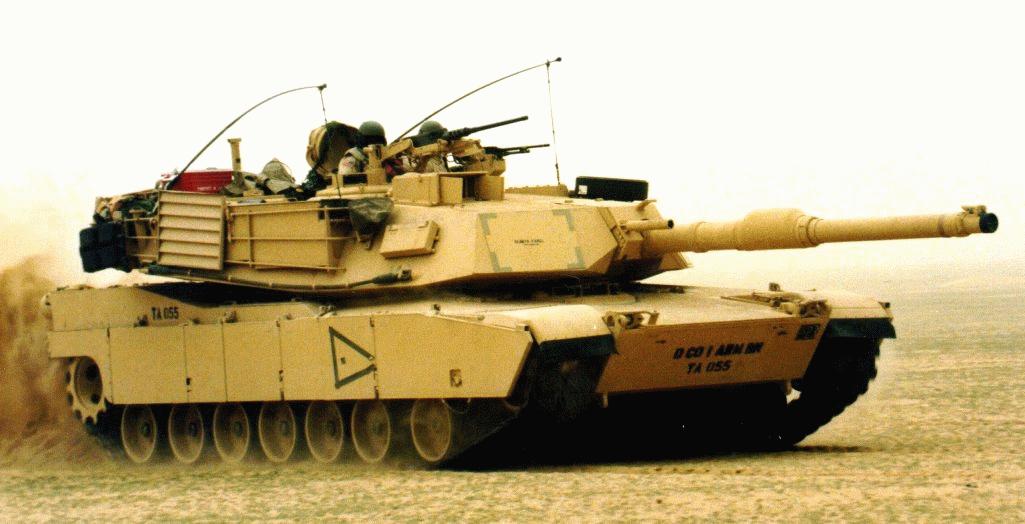|
 are acknowledged, affirmed and commemorated.
|
Posted on 03/10/2003 5:34:25 AM PST by SAMWolf
|
 are acknowledged, affirmed and commemorated.
|

|
|
|
(SOUTH) LEFT FLANK The Tawakalna Mechanized Division of the Republican Guard Forces Command was positioned about 25 miles west of the Kuwait border, located exactly in the center of the US 7th Corps' sector, The Tawakalna was probably the best division in the Iraqi Army. It had fought with distinction during the war with Iran and was one of the lead divisions in Saddam Husayn's invasion of Kuwait in August 1990. Its two mechanized brigades and one armored brigade were equipped with the most advanced equipment available in the Iraqi Army, including 220 T-72 tanks and 278 infantry fighting vehicles. On 25 February it had moved into a blocking position west of the Iraq Petroleum Saudi Arabia (IPSA) pipeline about 80 miles from Kuwait city. In spite of the air campaign, most of this division was in position and ready to fight when the US 7th Corps arrived on 26 February 1991.  The main battle began on the Tawakalna's (18th Mechanized Brigade's sector) left flank. At 3:30 pm on 26 February 1991, the US 2nd Squadron of the 2nd Armored Cavalry Regiment arrived at the edge of the Tawakalna's operation zone and destroyed three T-72 tanks. A few moments later it ran right into a battalion strong point of the 18th Iraqi Mechanized Brigade. Strong points consisted of dug in vehicle and soldier fighting positions, wire, mines and prepared fields of fire. In most cases the Iraqi units were in the right place, but had not developed their positions as well as they should have. In what was later known as the Battle of 73 Easting, the 2nd Squadron attacked. It was a short, but violent battle. Iraqi vehicles exploded as 120mm rounds found their marks. US scout platoons followed the M1 tanks providing "scratching fires" to protect the US tanks from the Iraqi infantry. Just as the 2nd Squadron arrived at the rear of the battalion strong point the Iraqis launched a counterattack. While brave, it was ineffective. In 23 minutes one troop from the US squadron destroyed over half of the Iraqi battalion. The 3rd Squadron moved just to the south of the 2nd Squadron and attacked the southern portion of the same Iraqi strong point at about 3:30 pm. At 4:45 pm, the Iraqis launched a counter-attack against the US 3rd Squadron with a T-72 tank company. At 2,500 meters, they fired at the Bradley cavalry fighting vehicles. The range was too great and their rounds struck the earth just short of their intended targets. They were unable to get many more rounds off as M1 tanks bounded forward and, at about 2,100 meters, destroyed most of the Iraqi T-72 tanks.  The US attack must have surprised the Iraqi battalion. The Iraqi crews were out of their tanks and infantry fighting vehicles because of the danger of air attacks, although the division commander must have had an idea that he was about to be attacked by a large force because his forward security forces and, one would hope, the Iraqi High Command or Republican Guard Forces Command headquarters would have given him warning. The word, however, did not find its way down to the front-line battalions and, especially, the individual tank and fighting vehicle crews, since no one ordered the Tawakalna battalion to prepare for immediate battle. At best, the Americans' attack speed was faster than the Tawakalna Division's orders process. At worst, no one on the Iraqi staff thought of telling the front-line units to prepare. The US attacked so violently that the Iraqis never had time to get back into their vehicles. The Iraqi battalion, also, did not prepare its positions very well: obstacles were obviously not complete, and it had emplaced only a few of its mines. Based on their experience in the Iran War, Iraqi defensive positions have lots of mines, barbed wire and other obstacles to stop the attacker. They dig in their vehicles deep into the ground, with just the turrets exposed so the guns can acquire targets. Unfortunately, the Tawakalna Division was only able to develop partially its defenses. The reasons may be lack of time, the effect of coalition jet aircraft flying overhead, and/or lack of materials (such as mines or wire). Franks' orders to Colonel Don Holder, the 2nd Armored Cavalry Regiment commander, were to avoid a decisive engagement. Holder's troops had successfully destroyed one Iraqi battalion strong point, but there were still at least six or seven more battalions waiting for the US regiment, which did not have the combat power to break through the Tawakalna's defenses. Holder, therefore ordered his squadrons to hold at their current positions and prepare to pass the 1st Infantry Division, which had moved behind the Regiment, forward. The fight in the 2nd Armored Cavalry Regiment's sector, however, was not yet over. Around 6 pm on 26 February, the character of the battle changed as dismounted Iraqi infantry, T-55 tanks and MT-LBs began a series of attacks on 2nd Squadron's positions along the 73 Easting. Iraqi infantry, believing that darkness and poor visibility would protect them, charged towards the US troopers firing their AK assault rifles and RPG anti-tank rockets. The US 2nd Squadron's defensive firepower, however, stopped the Iraqi attacks. US TOW anti-tank missiles destroyed several trucks loaded with Iraqi soldiers. M1 tanks demolished T-55 and T-72 tanks long before they got within their own firing range. The squadron's mortar sections began firing airbursts at the Iraqi infantry causing them either to retreat or dig in. In several hours of combat, the US squadron knocked out at least two companies of Iraqi tanks. Hundreds of Iraqi infantry and their lightly armored transporters lay scattered on the floor of a small wadi, or dry stream bed, nearby.  Shortly before 10:30 pm, it was suddenly quiet across the thirty kilometers in front of the Iraqi 18th Mechanized and 37th Armored Brigades. The 2nd US Armored Cavalry Regiment held its fire as the 1st Infantry Division began its forward passage of lines. Passage lanes are clearly marked routes that the moving unit uses to pass through the stationary unit. These routes may be marked by variouus means, including pyrotechnics, reflective or white tape, and even simple road signs. In most cases, the entry and exit of the lane is manned by members of both the moving and stationary unit to minimize confusion. Because the attack had stopped, the Tawakalna commander probably thought he had stopped the American advance on his left flank. Nothing, however could have been further from the truth. Just as the soldiers of the 2nd Squadron were defending against the Iraqi counter-attacks, the 1st Infantry Division began its final move towards the 73 Easting. American scouts on the forward line fired green star clusters to mark the exact passage lanes. Then, past tired 2nd US Cavalry soldiers and burning Iraqi T-72 tanks, the 1st US Infantry Division resumed the attack. Now, instead of three armored cavalry squadrons, the 18th and 37th Iraqi Armored Brigades faced six heavy battalions of American tanks and infantry fighting vehicles and another six battalions of 155mm field artillery. The Iraqis, however, did not run. Instead, they manned their vehicles and weapons systems against the US forces. In the 1st US Brigade sector all of the battalions used a single passage lane. Each unit had its own area of operations to keep it from becoming confused with other units and to ensure that each unit achieved the command's common objective. Since these were only imaginary lines on the ground, units often strayed into adjacent sectors. The first battalion (1-34 Armor) that passed through the passage lane ran into a battalion from the Iraqi 18th Mechanized Brigade, and Iraqi gunners were able to indentify two American vehicles and destroy them, killing one soldier and wounding five others. The American commander pulled his scouts back and moved his tank companies forward. The second American battalion (Task Force 2-34 Armor) that passed through the passage lane became momentarily lost because it was dark and the combat equipment (in spite of rumors about super technology) did not have a compass or directional aid built into the vehicle. And the third (Task Force 5-16 Infantry) was not yet through the passage lane.  In the south, the 1st Infantry Division's 3rd Brigade moved through three separate passage lanes, where each battalion almost immediately made contact with the Iraqi defenders and both sides started shooting at each other. The primary fighting force in this sector were two battalions of the 37th Iraqi Armored Brigade, defending the left flank of the Tawakalna. The assault of the 3rd US Brigade also caught many Iraqi tank crews on the ground in their shelters, probably hiding from American air and artillery attacks. Because they had not turned on their engines and were not, therefore, generating heat, the tanks did not show up on the American's vehicle-mounted thermal sights. In many instances, American vehicles simply drove past the Iraqi positions. For the next few hours, bypassed Iraqi RPG equipped anti-tank teams and dismounted Iraqi infantry fired at passing American vehicles, only to be destroyed by other US tanks and fighting vehicles following the initial forces. As Iraqi RPG teams and T-55 tanks maneuvered to shoot the Americans in their vulnerable rear, some M1 and Bradley turrets swung back to engage their attackers. Responding to apparent enemy fire, friendly crews returned fire. When the confusing mélée was over, the 1st Division tanks discovered that they had destroyed five of their own M1 tanks and four Bradleys. Six brigade soldiers perished in these attacks and thirty others were wounded. Rather than "press the attack" as those at Central Command (General Norman Schwarzkopf's headquarters) were demanding, the brigade commander, Colonel David Weisman, decided to pull the battalions back, consolidate, and use his artillery to destroy the aggressive Iraqi infantry.  The Iraqis had stopped the 1st Infantry Division's initial push into their sector; but not for long. By 12:30 am on 27 February, the two attacking brigades of the 1st Infantry Division were positioned along the 75 Easting, 2,000 meters east of 73 Easting. For the next three hours they methodically crossed the remaining ten kilometers of their objective, called Objective Norfolk. The area encompassed the intersection of the IPSA Pipeline Road and several desert trails, as well as a large Iraqi supply depot. As they slowly advanced, M1 tank commanders acquired the thermal images of the Iraqi tanks, or infantry fighting vehicles, long before they were themselves spotted by the Iraqis. Platoon leaders, team commanders, and even battalion commanders issued unit-wide fire commands, causing the entire command to fire at Iraqi targets simultaneously. By dawn, the 1st US Infantry Division controlled Objective Norfolk. The combined attack of the 2nd Armored Cavalry Regiment's three squadrons and the Big Red One's two leading brigades had destroyed the two Iraqi brigades (18th Mechanized Brigade and 37th Armored Brigade) on the Tawakalna's left flank. Simultaneously with the fighting in the southern portion of its sector, the Tawakalna Division was under assault in the center of its line.
|
Boy! Ain't that the truth.



How's it going?


There are currently 16 recognized Armor Regiments and 15 Cavalry Regiments in the Regimental system for the active Armor force. These numbers include one Armor and two Cavalry Regiments for the training base at USAARMC. The lowest numbered CONUS-based battalion of the regiment will usually be designated regimental home-base having regimental responsibility and will maintain the regimental colors and memorabilia. When all battalions are OCONUS, usually the lowest numbered OCONUS battalion or squadron assumes regimental responsibility and maintains regimental colors and memorabilia.
There's absolutely no difference between armor officers and cavalry officers. They are in a sense the same. Armor officers have a unique opportunity to serve in both heavy tank battalions as well as various cavalry organizations throughout their military career. Although the missions differ throughout the many organizations, there is no better unit than another. Armor branch discourages repeat assignments to the same type of organization.

Lieutenants serving as a platoon leader in Korea clearly get an opportunity to develop their leadership skills and receive professional development at an accelerated rate when compared to the majority of their Armor officer peers. Training in Korea is intensely METL focused due to 'real world missions', and leaders can rely on getting a priority placed on personnel and resources directed to Korea. In the end, that means more training and fewer distractions for junior armor officers assigned to Korea.
The history of Armor and Cavalry is intertwined with the history of America. From 1776, when General Washington recommended the establishment of one or more mounted units in the Continental Army, the history of the mounted branch traveled on with that of the nation.

In March 1833, the First Regiment of Dragoons was formed. In every war since, cavalry or armor has played its vital role. Mexico - when cavalry led Scott's and Taylor's armies, and culminated the war with the capture of Chapultpec Castle. The Civil War - when cavalry of blue and grey struggled through bitter years. The Indian Wars - when cavalry fought to protect what was gained and expanded our horizons. The Spanish-American War - when cavalry rode to victory in Cuba, Puerto Rico, and the Philippines. Mexico again - when the cavalry pursued Pancho Villa during the Punitive Expedition.
On 26 January 1918, the Tank Corps of the American Expeditionary Force was formed and on 12 September 1918 went into initial action at St. Mihiel. Ten years later, the Experimental Mechanized Force was formed at Fort Meade, Maryland, but it lasted only two months.

The exigencies of the service prevailed and the foundling armored force was swept to and fro until the fall of 1931. The fledgling Mechanized Force came to Camp Knox, Kentucky. In 1936, the 7th Cavalry Brigade (Mechanized) was formed at Fort Knox.
On 10 July 1940, Fort Knox became the Home of Armor with the creation of an Armored Force. Kentucky tankers fought to the bitter end on Bataan, and the 26th Cavalry fought the last horse-mounted action in the Philippines.

But it was not to stay, and tankers assembled again to defend liberty. Korea and the Army Organization Act of 1950, when armor was named one of the basic branches and specified as a continuation of cavalry. Between Korea and Vietnam, a new doctrine came into being, air cavalry and attack helicopters came into their own. New days, new doctrine. Armor advanced with the times. Combined Arms was the theme, with infantry, artillery, and aviation working together with the Combat Arm of Decision. Operation Desert Storm - when this potent mix of force and doctrine overwhelmed Iraq.

The heritage began in cavalry - it continues in armor. The spirit of the attack, armor shock and firepower, the will to fight, to close rapidly with the enemy - these are today and tomorrow the hallmarks of armor.
Globalsecurity.org
Holder will always be "The Colonel" to me, no matter how many stars he gets.
Damn shame they practically deactivated the 2 ACR after Desert Storm.

It's a good likeness of the Colonel, and I think that's the old XO kneeling on the map. Great memories, thanks SAMWolf!
Disclaimer: Opinions posted on Free Republic are those of the individual posters and do not necessarily represent the opinion of Free Republic or its management. All materials posted herein are protected by copyright law and the exemption for fair use of copyrighted works.